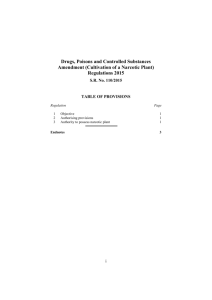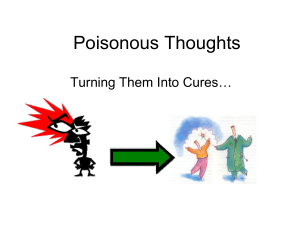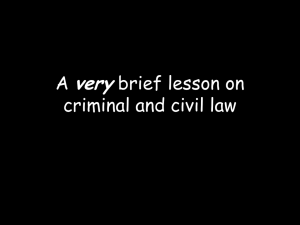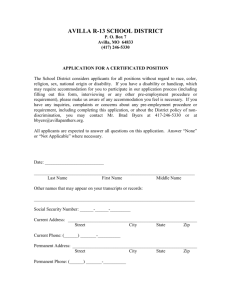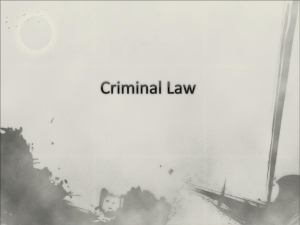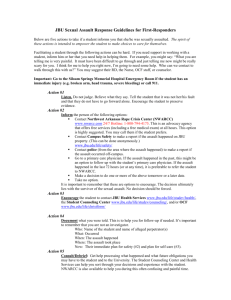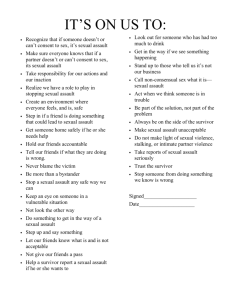File
advertisement
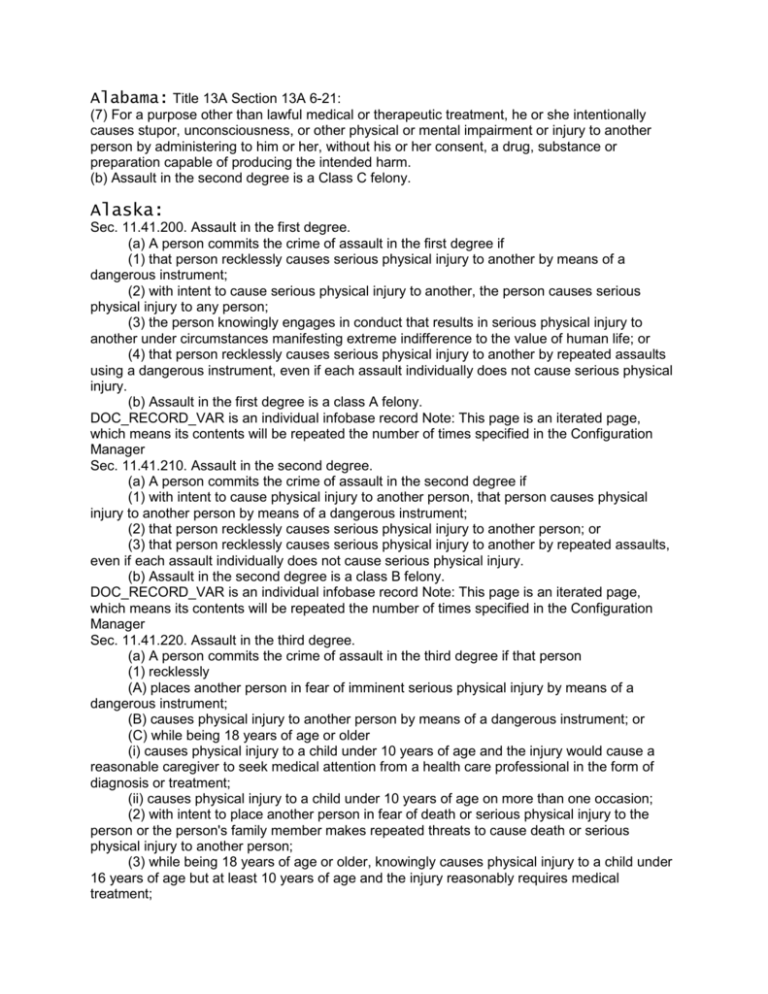
Alabama: Title 13A Section 13A 6-21: (7) For a purpose other than lawful medical or therapeutic treatment, he or she intentionally causes stupor, unconsciousness, or other physical or mental impairment or injury to another person by administering to him or her, without his or her consent, a drug, substance or preparation capable of producing the intended harm. (b) Assault in the second degree is a Class C felony. Alaska: Sec. 11.41.200. Assault in the first degree. (a) A person commits the crime of assault in the first degree if (1) that person recklessly causes serious physical injury to another by means of a dangerous instrument; (2) with intent to cause serious physical injury to another, the person causes serious physical injury to any person; (3) the person knowingly engages in conduct that results in serious physical injury to another under circumstances manifesting extreme indifference to the value of human life; or (4) that person recklessly causes serious physical injury to another by repeated assaults using a dangerous instrument, even if each assault individually does not cause serious physical injury. (b) Assault in the first degree is a class A felony. DOC_RECORD_VAR is an individual infobase record Note: This page is an iterated page, which means its contents will be repeated the number of times specified in the Configuration Manager Sec. 11.41.210. Assault in the second degree. (a) A person commits the crime of assault in the second degree if (1) with intent to cause physical injury to another person, that person causes physical injury to another person by means of a dangerous instrument; (2) that person recklessly causes serious physical injury to another person; or (3) that person recklessly causes serious physical injury to another by repeated assaults, even if each assault individually does not cause serious physical injury. (b) Assault in the second degree is a class B felony. DOC_RECORD_VAR is an individual infobase record Note: This page is an iterated page, which means its contents will be repeated the number of times specified in the Configuration Manager Sec. 11.41.220. Assault in the third degree. (a) A person commits the crime of assault in the third degree if that person (1) recklessly (A) places another person in fear of imminent serious physical injury by means of a dangerous instrument; (B) causes physical injury to another person by means of a dangerous instrument; or (C) while being 18 years of age or older (i) causes physical injury to a child under 10 years of age and the injury would cause a reasonable caregiver to seek medical attention from a health care professional in the form of diagnosis or treatment; (ii) causes physical injury to a child under 10 years of age on more than one occasion; (2) with intent to place another person in fear of death or serious physical injury to the person or the person's family member makes repeated threats to cause death or serious physical injury to another person; (3) while being 18 years of age or older, knowingly causes physical injury to a child under 16 years of age but at least 10 years of age and the injury reasonably requires medical treatment; (4) with criminal negligence causes serious physical injury under AS 11.81.900(b)(56)(B) to another person by means of a dangerous instrument; or (5) commits a crime that is a violation of AS 11.41.230 (a)(1) or (2) and, within the preceding 10 years, the person was convicted on two or more separate occasions of crimes under (A) AS 11.41.100 - 11.41.170; (B) AS 11.41.200 - 11.41.220, 11.41.230(a)(1) or (2), 11.41.280, or 11.41.282; (C) AS 11.41.260 or 11.41.270; (D) AS 11.41.410 , 11.41.420, or 11.41.425(a)(1); or (E) a law or ordinance of this or another jurisdiction with elements similar to those of an offense described in (A) - (D) of this paragraph. (b) In a prosecution under (a)(3) of this section, it is an affirmative defense that, at the time of the alleged offense, the defendant reasonably believed the victim to be 16 years of age or older, unless the victim was under 13 years of age at the time of the alleged offense. (c) In (a)(5) of this section, when considering whether a conviction has occurred in the preceding 10 years, the date that sentence is imposed is the date that a previous conviction has occurred. (d) In this section, "the person's family member" means (1) a spouse, child, grandchild, parent, grandparent, sibling, uncle, aunt, nephew, or niece, of the person, whether related by blood, marriage, or adoption; (2) a person who lives or has lived, in a spousal relationship with the person; (3) a person who lives in the same household as the person; or (4) a person who is a former spouse of the person or is or has been in a dating, courtship, or engagement relationship with the person. (e) Assault in the third degree is a class C felony. DOC_RECORD_VAR is an individual infobase record Note: This page is an iterated page, which means its contents will be repeated the number of times specified in the Configuration Manager Sec. 11.41.230. Assault in the fourth degree. (a) A person commits the crime of assault in the fourth degree if (1) that person recklessly causes physical injury to another person; (2) with criminal negligence that person causes physical injury to another person by means of a dangerous instrument; or (3) by words or other conduct that person recklessly places another person in fear of imminent physical injury. (b) Assault in the fourth degree is a class A misdemeanor. DOC_RECORD_VAR is an individual infobase record Note: This page is an iterated page, which means its contents will be repeated the number of times specified in the Configuration Manager Sec. 11.41.250. Reckless endangerment. (a) A person commits the crime of reckless endangerment if the person recklessly engages in conduct which creates a substantial risk of serious physical injury to another person. (b) Reckless endangerment is a class A misdemeanor. DOC_RECORD_VAR is an individual infobase record Note: This page is an iterated page, which means its contents will be repeated the number of times specified in the Configuration Manager Arizona: 13-1205. Unlawfully administering intoxicating liquors, narcotic drug or dangerous drug; classification A. A person commits unlawfully administering intoxicating liquors, a narcotic drug or dangerous drug if, for a purpose other than lawful medical or therapeutic treatment, such person knowingly introduces or causes to be introduced into the body of another person, without such other person's consent, intoxicating liquors, a narcotic drug or dangerous drug. B. Unlawfully administering intoxicating liquors, a narcotic drug or dangerous drug is a class 6 felony. C. If the victim is a minor, then the offense shall be a class 5 felony. Arkansas: -*-*California: 222. Every person guilty of administering to another any chloroform, ether, laudanum, or any controlled substance, anaesthetic, or intoxicating agent, with intent thereby to enable or assist himself or herself or any other person to commit a felony, is guilty of a felony punishable by imprisonment in the state prison for 16 months, or two or three years. Colorado: 18-3-203. Assault in the second degree (1) A person commits the crime of assault in the second degree if: (a) Repealed. (b) With intent to cause bodily injury to another person, he or she causes such injury to any person by means of a deadly weapon; or (c) With intent to prevent one whom he or she knows, or should know, to be a peace officer, firefighter, or emergency medical service provider from performing a lawful duty, he or she intentionally causes bodily injury to any person; or (d) He recklessly causes serious bodily injury to another person by means of a deadly weapon; or (e) For a purpose other than lawful medical or therapeutic treatment, he intentionally causes stupor, unconsciousness, or other physical or mental impairment or injury to another person by administering to him, without his consent, a drug, substance, or preparation capable of producing the intended harm; or Connecticut: Delaware: 625 Unlawfully administering drugs; class A misdemeanor. A person is guilty of unlawfully administering drugs when, for a purpose other than lawful medical or therapeutic treatment, the person intentionally causes stupor, unconsciousness or other alteration of the physical or mental condition of another person by administering to the other person, without consent, a drug. Unlawfully administering drugs is a class A misdemeanor. (11 Del. C. 1953, § 625; 58 Del. Laws, c. 497, § 1; 67 Del. Laws, c. 130, § 8; 70 Del. Laws, c. 186, § 1.) § 626 Unlawfully administering controlled substance or counterfeit substance or narcotic drugs; class G felony. A person is guilty of unlawfully administering a controlled substance or counterfeit substance or narcotic drugs when, for a purpose other than lawful medical or therapeutic treatment, the person intentionally introduces or causes introduction into the body of another person, without consent, a controlled substance or counterfeit substance or narcotic drug. Unlawfully administering controlled substance or counterfeit substance or narcotic drugs is a class G felony. (11 Del. C. 1953, § 626; 58 Del. Laws, c. 497, § 1; 67 Del. Laws, c. 130, § 8; 70 Del. Laws, c. 186, § 1.) § 627 Prohibited acts as to substances releasing vapors or fumes; unclassified misdemeanor. No person shall: (1) Intentionally smell or inhale the vapors or fumes from any substance having the property of releasing vapors or fumes for the purpose of producing a condition of intoxication, inebriation, exhilaration, stupefaction or lethargy or for the purpose of dulling the brain or nervous system; provided, that nothing in this section shall prohibit the inhalation of the vapors or fumes of any anesthesia for medical or dental purposes; (2) Sell or offer to sell to any person any material, product or article of commerce containing any substance having a property of releasing vapors or fumes, if the person has knowledge or is in the possession of such facts that the person should have knowledge that the material, product or article of commerce sold or offered will be used for the purpose of committing any of the acts proscribed in paragraph (1) of this section; (3) Purchase or offer to purchase for the person or any other person any material, product or article of commerce containing any substance having the property of releasing vapors and fumes if such purchase or offer to purchase is made for the purpose of committing any of the acts proscribed in paragraph (1) of this section. Any violation of this section shall be an unclassified misdemeanor. (11 Del. C. 1953, § 627; 58 Del. Laws, c. 497, § 1; 65 Del. Laws, c. 286, § 1; 67 Del. Laws, c. 130, § 8; 70 Del. Laws, c. 186, § 1.) Florida:Title XLVI CRIMES Chapter 859 POISONS; ADULTERATED DRUGS View Entire Chapter 859.01 Poisoning food or water.—Whoever introduces, adds, or mingles any poison, bacterium, radioactive material, virus, or chemical compound with food, drink, medicine, or any product designed to be ingested, consumed, or applied to the body with intent to kill or injure another person, or willfully poisons or introduces, adds, or mingles any bacterium, radioactive material, virus, or chemical compound into any spring, well, or reservoir of water with such intent, commits a felony of the first degree, punishable as provided in s. 775.082, s. 775.083, or s. 775.084. History.—s. 4, ch. 1637, 1868; RS 2658; GS 3587; RGS 5515; CGL 7675; s. 1078, ch. 71-136; s. 1, ch. 2001-358. Title XLVI CRIMES Chapter 859 POISONS; ADULTERATED DRUGS View Entire Chapter 859.02 Selling certain poisons by registered pharmacists and others.—Any violation of the law, relative to sale of poisons, not specially provided for, shall constitute a misdemeanor of the second degree, punishable as provided in s. 775.083. History.—s. 8, ch. 3880, 1889; GS 1906, 3604; RGS 5526; CGL 7692; s. 1079, ch. 71-136. Title XLVI CRIMES Chapter 859 POISONS; ADULTERATED DRUGS View Entire Chapter 859.04 Provisions concerning poisons.— (1) It is unlawful for any person not a registered pharmacist to retail any poisons enumerated below: Arsenic and all its preparations, corrosive sublimate, white and red precipitate, biniodide of mercury, cyanide of potassium, hydrocyanic acid, strychnine, and all other poisonous vegetable alkaloids and their salts, and the essential oil of almonds, opium, and its preparations of opium containing less than two grains to the ounce, aconite, belladonna, colchicum, conium, nux vomica, henbane, savin, ergot, cotton root, cantharides, creosote, veratrum digitalis, and their pharmaceutical preparations, croton oil, chloroform, chloral hydrate, sulphate of zinc, mineral acids, carbolic and oxalic acids; and she or he shall label the box, vessel, or paper in which said poison is contained with the name of the article, the word “poison,” and the name and place of business of the seller. (2) No person shall deliver or sell any poisons enumerated above unless upon due inquiry it be found that the purchaser is aware of its poisonous character and represents that it is to be used for a legitimate purpose. The provisions of this section shall not apply to the dispensing of poisons in not unusual quantities or doses upon the prescriptions of practitioners of medicine. (3) Any violation of this section shall render the principal of said store guilty of a misdemeanor of the second degree, punishable as provided in s. 775.083. However, this section shall not apply to manufacturers making and selling at wholesale any of the above poisons. Each box, vessel, or paper in which said poison is contained shall be labeled with the name of the article, the word “poison,” and the name and place of business of the seller. History.—s. 8, ch. 3380, 1889; RS 822; GS 3606; RGS 5528; CGL 7694; s. 1081, ch. 71-136; s. 1386, ch. 97-102. Georgia: -*-*Hawaii: -*-*Idaho:TITLE 18 CRIMES AND PUNISHMENTS CHAPTER 9 ASSAULT AND BATTERY 18-914. FELONIOUS ADMINISTERING OF DRUGS -- PUNISHMENT. A felonious administering of drugs is punishable by imprisonment in the state prison not to exceed five (5) years or five thousand ($5,000) dollars, or both. History: [18-914, added 1979, ch. 227, sec. 2, p. 626. Illinois: (720 ILCS 5/12-3.05) (was 720 ILCS 5/12-4) Sec. 12-3.05. Aggravated battery. (f) Offense based on use of a weapon or device. A person commits aggravated battery when, in committing a battery, he or she does any of the following: (g) Offense based on certain conduct. A person commits aggravated battery when, other than by discharge of a firearm, he or she does any of the following: (1) Violates Section 401 of the Illinois Controlled Substances Act by unlawfully delivering a controlled substance to another and any user experiences great bodily harm or permanent disability as a result of the injection, inhalation, or ingestion of any amount of the controlled substance. (2) Knowingly administers to an individual or causes him or her to take, without his or her consent or by threat or deception, and for other than medical purposes, any intoxicating, poisonous, stupefying, narcotic, anesthetic, or controlled substance, or gives to another person any food containing any substance or object intended to cause physical injury if eaten. Indiana: Iowa: Kansas: Article 54 21-5425. Unlawful administration of a substance. (a) Unlawful administration of a substance is the administration of a substance to another person without consent with the intent to impair such other person's physical or mental ability to appraise or control such person's conduct. (b) Unlawful administration of a substance is a class A person misdemeanor. (c) This section shall not prohibit administration of any substance described in subsection (d) for lawful medical or therapeutic treatment. (d) As used in this section, "administration of a substance" means any method of causing the ingestion by another person of a controlled substance, including gamma hydroxybutyric acid, or any controlled substance analog, as defined in K.S.A. 65-4101, and amendments thereto, of gamma hydroxybutyric acid, including gamma butyrolactone; butyrolactone; butyrolactone gamma; 4-butyrolactone; 2(3H)-furanone dihydro; dihydro-2(3H)-furanone; tetrahydro-2furanone; 1,2-butanolide; 1,4-butanolide; 4-butanolide; gamma-hydroxybutyric acid lactone; 3hydroxybutyric acid lactone and 4-hydroxybutanoic acid lactone with CAS No. 96-48-0; 1,4 butanediol; butanediol; butane-1,4-diol; 1,4-butylene glycol; butylene glycol; 1,4dihydroxybutane; 1,4-tetramethylene glycol; tetramethylene glycol; tetramethylene 1,4-diol. History: L. 2010, ch. 136, § 60; L. 2011, ch. 30, § 25; July 1. Kentucky: Louisiana: (3) "Dangerous weapon" includes any gas, liquid or other substance or instrumentality, which, in the manner used, is calculated or likely to produce death or great bodily harm. Maine: §803-A. Causing a catastrophe 1. A person is guilty of causing a catastrophe if the person recklessly causes a catastrophe by explosion, fire, flood, avalanche, collapse of a structure, release or dissemination of poison, toxin, radioactive material, bacteria, virus or other biological agent or vector or other such force or substance that is dangerous to human life and difficult to confine. [ 2001, c. 634, §6 (NEW) .] 2. A person is guilty of causing a catastrophe if the person with terroristic intent violates subsection 1. [ 2001, c. 634, §6 (NEW) .] 3. As used in this section, the following definitions apply. A. "Biological agent" means any microorganism, virus, infectious substance, product of biotechnology or component of any such agent, either naturally occurring or bioengineered. [2001, c. 634, §6 (NEW).] B. "Catastrophe" means: (1) For purposes of subsection 1, death or serious bodily injury to 10 or more persons or substantial damage to 5 or more structures, whether or not occupied; and (2) For purposes of subsection 2, death or serious bodily injury to more than one person, substantial damage to 3 or more structures, whether or not occupied, or substantial physical damage sufficient to disrupt the normal functioning of a critical infrastructure. [2001, c. 634, §6 (NEW).] C. "Poison" means toxic or poisonous chemicals or precursors of toxic or poisonous chemicals. [2001, c. 634, §6 (NEW).] D. "Toxin" means the toxic material of plants, animals, microorganisms, viruses, fungi or infectious substances or a recombinant molecule, whatever its origin or method of production, including: (1) Any poisonous substance or biological product of biotechnology produced by a living organism; or (2) Any poisonous isomer or biological product, homolog or derivative of such a substance. [2001, c. 634, §6 (NEW).] E. "Vector" means a living organism or molecule, including a recombinant molecule or any biological product of biotechnology, capable of carrying a biological agent or toxin to a host. [2001, c. 634, §6 (NEW).] [ 2001, c. 634, §6 (NEW) .] 4. Causing a catastrophe is a Class A crime. [ 2001, c. 634, §6 (NEW) .] SECTION HISTORY 2001, c. 634, §6 (NEW). Maryland: Massachusetts: Michigan: Minnesota: Mississippi: Missouri: Montana: Nebraska: Nevada: New Hampshire: New Jersey: New Mexico: New York: North Carolina: North Dakota: Ohio: Oklahoma: Oregon: Pennsylvania: Rhode Island: South Carolina: South Dakota: Tenesse: Texas: Utah: Vermont: Virginia: Washington: West Virginia: Wisconsin: Wyoming:

